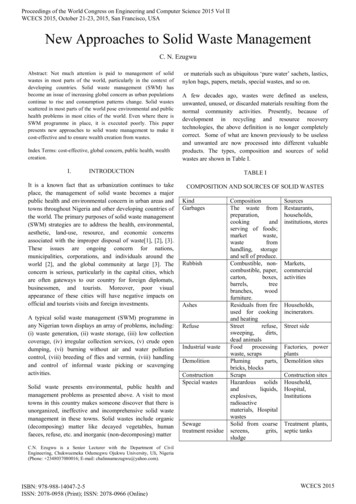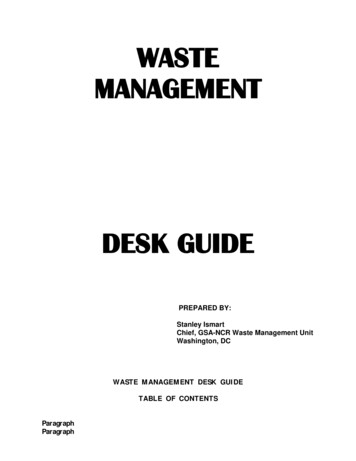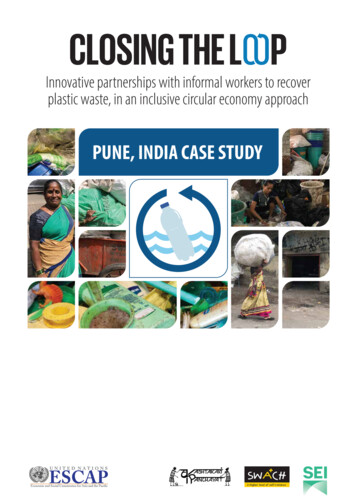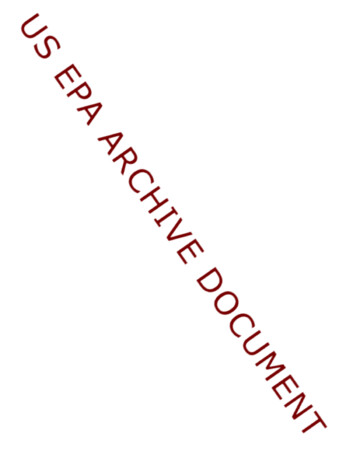
Transcription
Proceedings of the World Congress on Engineering and Computer Science 2015 Vol IIWCECS 2015, October 21-23, 2015, San Francisco, USANew Approaches to Solid Waste ManagementC. N. EzugwuAbstract: Not much attention is paid to management of solidwastes in most parts of the world, particularly in the context ofdeveloping countries. Solid waste management (SWM) hasbecome an issue of increasing global concern as urban populationscontinue to rise and consumption patterns change. Solid wastesscattered in most parts of the world pose environmental and publichealth problems in most cities of the world. Even where there isSWM programme in place, it is executed poorly. This paperpresents new approaches to solid waste management to make itcost-effective and to ensure wealth creation from wastes.Index Terms: cost-effective, global concern, public health, wealthcreation.I.or materials such as ubiquitous ‘pure water’ sachets, lastics,nylon bags, papers, metals, special wastes, and so on.A few decades ago, wastes were defined as useless,unwanted, unused, or discarded materials resulting from thenormal community activities. Presently, because ofdevelopment in recycling and resource recoverytechnologies, the above definition is no longer completelycorrect. Some of what are known previously to be uselessand unwanted are now processed into different valuableproducts. The types, composition and sources of solidwastes are shown in Table I.INTRODUCTIONIt is a known fact that as urbanization continues to takeplace, the management of solid waste becomes a majorpublic health and environmental concern in urban areas andtowns throughout Nigeria and other developing countries ofthe world. The primary purposes of solid waste management(SWM) strategies are to address the health, environmental,aesthetic, land-use, resource, and economic concernsassociated with the improper disposal of waste[1], [2], [3].These issues are ongoing concern for nations,municipalities, corporations, and individuals around theworld [2], and the global community at large [3]. Theconcern is serious, particularly in the capital cities, whichare often gateways to our country for foreign diplomats,businessmen, and tourists. Moreover, poor visualappearance of these cities will have negative impacts onofficial and tourists visits and foreign investments.A typical solid waste management (SWM) programme inany Nigerian town displays an array of problems, including:(i) waste generation, (ii) waste storage, (iii) low collectioncoverage, (iv) irregular collection services, (v) crude opendumping, (vi) burning without air and water pollutioncontrol, (viii) breeding of flies and vermin, (viii) handlingand control of informal waste picking or scavengingactivities.Solid waste presents environmental, public health andmanagement problems as presented above. A visit to mosttowns in this country makes someone discover that there isunorganized, ineffective and incomprehensive solid wastemanagement in these towns. Solid wastes include organic(decomposing) matter like decayed vegetables, humanfaeces, refuse, etc. and inorganic (non-decomposing) matterTABLE ICOMPOSITION AND SOURCES OF SOLID WASTESKindGarbagesRubbishAshesRefuseIndustrial wasteDemolitionConstructionSpecial wastesSewagetreatment residueCompositionThe waste frompreparation,cookingandserving of foods;marketwaste,wastefromhandling, storageand sell of produce.Combustible, noncombustible, ure.Residuals from fireused for cookingand heatingStreetrefuse,sweeping,dirts,dead animalsFoodprocessingwaste, scrapsPlumingparts,bricks, blocksScrapsHazardous solidsandliquids,explosives,radioactivematerials, HospitalwastesSolid from holds,institutions, erators.Street sideFactories, powerplantsDemolition sitesConstruction sitesHousehold,Hospital,InstitutionsTreatment plants,septic tanksC.N. Ezugwu is a Senior Lecturer with the Department of CivilEngineering, Chukwuemeka Odumegwu Ojukwu University, Uli, Nigeria(Phone: 2348037080016; E-mail: chalinnamezugwu@yahoo.com).ISBN: 978-988-14047-2-5ISSN: 2078-0958 (Print); ISSN: 2078-0966 (Online)WCECS 2015
Proceedings of the World Congress on Engineering and Computer Science 2015 Vol IIWCECS 2015, October 21-23, 2015, San Francisco, USAAHistorical Background of SWMFrom ancient times, people have been mass-producing solidwaste. Most communities manage to burry solid waste justoutside their settlements or dispose of it in nearby rivers orwater bodies, but as population densities increased, thesepractices no longer prevented the spread of foul odours ordisease [4]. As waste accumulated in these growingcommunities, people simply lived amongst the filth. Therewere exceptions: organized SWM processes wereimplemented in ancient city of Mahenjo-Daro in the IndusValley by 2000 BC [5]; the Greeks had both issued a decreebanning waste disposal in the streets and organized theWestern world’s first acknowledged “municipal dumps” by500 BC [6]; the Chinese cities had “disposal police”responsible for enforcing disposal laws by 200 BC. In bothAthens and Rome, waste was only relocated well outsidecity boundaries when defenses were threatened becauseopponents could scale up the refuse piles and over the citywalls [5].City streets in the Middle Ages were plastered in anodourous mud composed of soil, stagnant water, householdwaste, and animal and human excreatment [7]. Thissituation created very favourable conditions for vectors ofdisease. Indeed, the Black Death, which struck Europe in theearly 1300s, may have been partially caused by the litteringof organic wastes in the streets [7]; [8]; [5]. In colonianAmerica, the urban population lived in similar putridconditions [6]. However, scarcity of resources ensured manyitems were repaired and reused, and the waste stream wasthoroughly scavenged [9].SWM contex in a developing country is presented in Fig 1.Fig. 1: Developing country SWM contextISBN: 978-988-14047-2-5ISSN: 2078-0958 (Print); ISSN: 2078-0966 (Online)WCECS 2015
Proceedings of the World Congress on Engineering and Computer Science 2015 Vol IIWCECS 2015, October 21-23, 2015, San Francisco, USAII. NEW APPROACHES TO SWMNew approaches in SWM are adopted to ensure that it iscomprehensive, organized, cost-effective, creates wealth,environment friendly and protects public health.Employment of 4RsThe 4Rs in waste management are Reduction, Recycling,Reuse and Recovery.A. ReductionThis is a process by which the size of waste is reduced asmuch as possible. This makes the landfill sites and transferstations last longer. So, size-reduction of refuse is necessary.Machines used to achieve this are called shredders. It couldbe achieved manually. Moreover, reduction could beachieved from source by controlling wastes generated. Forinstance, in office, paper wastes could be reduced by typingon both sides of the sheet and using single line spacingmethod as against typing on one side of the sheet and usingdouble line spacing method. By doing this, waste is reducedfour folds, if compared to the later. Also, waste reductioncould be achieved by cutting wastes in small bits(shredding), e.g. paper wastes, etc. Waste minimization isachieved by reducing the waste either by not generatingwaste at all, by changing the form of the waste (likeshredding paper wastes) or by extracting useful materialsfrom it.There is need for individuals to minimize their own wasteproduction, particularly of packaging materials.The idea ofreducing personal waste is carried out by rejecting goods thatare unnecessarily packaged, buying on the basis of re-usingeither the goods themselves or the associated packaging, andre-cycling as much as is practical [10].B. RecyclingIt is interesting to learn that what is termed waste can still beused if due attention is applied to identify how they can beso used. For instance, lead from used batteries could berecycled and used in production of new batteries. Also, purewater sachets littering everywhere could be shredded, put inlarge basin, melted and cast in a mould to produce objects ofdifferent shapes, eg. hollow tubes used by matriculatingstudents. So, this implies that there are resources in waste. Inwaste recycling, a waste component is extracted and usedagain in another manufacturing process. This helps tominimize what ends up in the sanitary landfill for ultimatedisposal, thereby making the landfill last longer. It isparticularly applicable to materials like plastics and steelwhich are not biodegradable.The extent to which recycling methods are used dependsvery much on the cost-benefit analysis of the process. If thecost of manufacturing an item from its raw materials is lessISBN: 978-988-14047-2-5ISSN: 2078-0958 (Print); ISSN: 2078-0966 (Online)than what it takes to induce recycled components, then thereis no economic incentive to recycle. For the mass of junk theprocess will remove from our waste mountains, it is worththe while to explore how optimally waste can be recycled[11].C. ReuseSome of the wastes generated and collected could be putinto use. Wastes that could be re-used include: off-cut ironin construction sites, re-useable bottles, etc. Also used tyrescould be shredded and used as aggregates for concreteworks to repair worn-out roads. These reuseable wastes aresorted out at source (i.e. at generation points or at transferstations by scavengers).D. RecoveryAny waste or discard material is technically worthless if itcannot, in its current form, be used. The value of a waste istherefore potential rather than real and depends entirely onits ability to be re-utilized [12].Resources recovery is the systematic diversion of waste,which was intended for disposal, for a specific next use [13].It is the processing of recyclables to extract or recovermaterials and resources, or convert to energy [14]. Theseactivities are performed at a resource recovery facility [14].Resource recovery is not only environmentally important,but it is also cost effective [15]. It decreases the amount ofwaste for disposal, saves space in landfills, and conservesnatural resources [15].Wherever any resource can be obtained in the wastemanagement process through a cost-effective method, thatrecovery must be encouraged [11]. For instance, there is alarge landfill site near the city of Los Angeles, Califonia,USA and it was discovered that the network of pipes hadbeen laid beneath the landfill that gathered methane gas.This gas was a product of the natural fermentation of thewaste. The gas collected was channeled to near by powergenerating station where the gas provided the steam thatdrove the turbines in steam turbines.Also, in another popular landfill at station Island, NewYork, USA, massive compacts from the dump site, afternatural fermentation of the organic waste, had been turnedinto fertilizer. These are good examples of how resourcesthat would otherwise have escaped into the biosphere wereconverted into something useful. Every resource recoverymove will be steered, with such extra-utility-derivation-ateconomic cost consideration in mind [16].In other to ensure effective employment of these wealthcreation measures, it is proposed that the proportions ofsolid wastes generation for different wealth creationactivities and landfilling for a typical community in aWCECS 2015
Proceedings of the World Congress on Engineering and Computer Science 2015 Vol IIWCECS 2015, October 21-23, 2015, San Francisco, USAdeveloping country should be as presented in Fig 2. Thisleads to minimization of wastes that finally go to landfills.prevention and recycling programmes, state-of-the-artlandfills and waste-to-energy very20%15%LandfillFig 2: Proportion of wastes generation for wealth creationactivities and landfilling.III.PUBLIC PRIVATE PARTNERSHIP (PPP) INSWMThe management of solid wastes is expensive and calls for awell-co-ordinated arrangement to ensure its effectivenessand sustainability [16]. There should be a public-privatepartnership to achieve this objective. Public enlightenmentprogramme should be carried out in mass and print media tocreate awareness. Since the financial resources required runsinto millions of naira, there is need for public-privatepartnership to source for funding the project. Moreover, theyshould organize its enforcement and monitoring to ensure itsimplementation. By partnering, the wealth created fromrecycling, re-use and wealth-to-energy measure should beshared by the partners.High capital costs for solid waste projects such asconstructing landfills and purchasing equipment along withoperating and maintenance costs present serious obstaclesfor many towns and communities, as well as insufficientaccess to training ad technical support programme hider theefforts of many communities to tackle SWM issues. Toovercome above barriers, there is need for public privatesector participation to raise resource to overcome these solidwaste management problems. The public and private sectorsshould partner by way of providing both human andfinancial resources to enhance effectiveness andsustainability of the project. State owned industries shouldpartner with private companies to put in place municipalSWM projects that might otherwise be difficult orunaffordable for a single individual or company. Forinstance, the public and private companies within an area ortown can purchase SWM equipment, such as collectiontrucks/vehicles to be used by the town. Partnerships can alsoprovide local communities environmental personnel withwider access to technical assistance, training programmesand financial support mechanisms. By working together,local government with limited resources can expand theirwaste management options to establish effective wasteISBN: 978-988-14047-2-5ISSN: 2078-0958 (Print); ISSN: 2078-0966 (Online)SANITARY LANDFILLING AS A WASTEDISPOSAL METHODSanitary landfill is to bury refuse containing biodegradableand non-biodegradable material, in a systematic andhygienic way without exerting any nuisance or hazard topublic health or safety [17]. Based on past experience incities throughout the world, the waste disposal in the form ofa sanitary landfill has proved to be most economical andacceptable method for the disposal of solid wastes. Landfilling is a complete and final means of disposal. Inincineration, perhaps more termed a waste volume reductiontechnique, for regardless of the operational efficiency of anyincinerator, total combustion can never be achieved andsome residue will remain requiring disposal. The classicaldefinition of a sanitary landfill is an engineered facility forthe disposal of municipal solid waste (MSW) designed andoperated to minimize public health hazards andenvironmental impacts [18]. This is preferred to othermethods because of the daily soil cover of the waste withattendant minimization of environmental impacts and publichealth hazards. The typical landfill consists of several cellsin which the waste is systematically placed.SWM progress finally began and was driven by fiveprincipal factors: public health, the environment, resourcescarcity and the value of waste, climate change, and publicawareness and participation. The driving forces and theprogress they instigated are depicted in Fig 3.IV.DISCUSSION AND CONCLUSIONIn most cities of the world especially in developingcountries, adequate attention is not paid to proper wastedisposal systems. The practice is mostly disposal of waste inopen dumps, incineration, composting etc. These practicesdegrade the environment and increase public healthhazards which can lead to outbreak of diseases. This workdiscussed new approach to SWM that will becomprehensive, cost-effective environment-friendly andsustainable. These new approaches to SMM lead to wealthcreation from wastes.V.DISCUSSION AND CONCLUSIONIn most cities of the world especially in developingcountries, adequate attention is not paid to proper wastedisposal systems. The practice is mostly disposal of waste inopen dumps, incineration, composting etc. These practicesdegrade the environment and increase public healthhazards which can lead to outbreak of diseases. This workdiscussed new approach to SWM that will becomprehensive, cost-effective environment-friendly andsustainable. These new approaches to SMM lead to wealthcreation from wastes.WCECS 2015
Proceedings of the World Congress on Engineering and Computer Science 2015 Vol IIWCECS 2015, October 21-23, 2015, San Francisco, USAFig. 3: SWM drivers and progressVI.DISCUSSION AND CONCLUSIONIn most cities of the world especially in developingcountries, adequate attention is not paid to proper wastedisposal systems. The practice is mostly disposal of waste inopen dumps, incineration, composting etc. These practicesdegrade the environment and increase public healthhazards which can lead to outbreak of diseases. This workdiscussed new approach to SWM that will becomprehensive, cost-effective environment-friendly andsustainable. These new approaches to SMM lead to wealthcreation from wastes. Government should sponsor public enlightenmentprogrammes to educate the public on ill-effects ofimproper handling of wastes. Those handling wastes according to laid down rulesshould be remunerated by appropriate authorities toencourage them. Sanitary landfilling should be adopted as finaldestination of these wastes to save our environment fromfurther degradation and to protect public health.REFERENCES[1]VII.RECOMMENDATIONS These new approaches to SWM should be adopted by allcities to achieve cost-effective SWM system. Thereshould be focus on the 4Rs to create wealth from thesewastes and to reduce the final wastes going into thelandfills.ISBN: 978-988-14047-2-5ISSN: 2078-0958 (Print); ISSN: 2078-0966 (Online)[2][3]Henry, R. K., Yongsheng, Z., and JunD. “Municipal solidwaste management challenges in developing countries.”Waste management, 2006, 26(1), pp. 92-100.Nemerow, N. L. “EnvironmentalEngineering.”Environmental Health andSafety for MunicipalInfrastructure,Land Use and Planning, and Industry,sixth ed. Wiley, Hoboken, N.J., 2009.W ilson, D. C. “Development drivers forwastemanagement.”Wastemanagement & Research, 25(3),2007, pp. 198-207.WCECS 2015
Proceedings of the World Congress on Engineering and Computer Science 2015 Vol IIWCECS 2015, October 21-23, 2015, San Francisco, 17][18]Seadon, J. K.” Integrated waste management-looking beyondthe solid waste horizon.” Waste Management, 26(12), 2006,1327-1336.Worrell,W.A. and Vesilind,P. A.”Solid Waste Engineering.”Second ed. Cengage Learning, Stamford,CT, 2012.Melosi, M.V. “Garbage in the cities: Refuse, Reform,and theEnvironment.”, 1880-1980, first ed. Texas A & M UniversityPress,College Station, Tex, 1981.Louis, G. E. “ A historical context of municipal solid wastemanagement in the united states,Waste Management &Research, 22(4), 306-322,2004.Tchobanoglous, G., Theisen, H., and Eliassen, R. “Solid Wastes:Engineering Principles and Management Issues.” Megraw-Hill,New York,Toronto, 1977.Woodward, D. “ Swords into ploughshares. Recycling in PreIndustrial England.” The Economic History Review, 38(2), 175191, 1985.Philpoth, M, J. “Voluntary collection schemes and recyclingcentres” in Henstock (edition 1983). Disposal and recovery ofmunicipal solid waste, Buther-worth & Co. Publishers.Odusote, A. O. “Comprehensive and Effective WasteManagement in Nigeria.” A presentation tothe technicalsession of the Nigerian Society of Engineers,Abuja Branch, 2003.Henstock, M. E. “Disposal and Recovery of Municipal SolidWaste.” Buther-worth & Co. Publishers,1983.USEPA. “Frequent Questions.” qs.htm.Government of Montonia. “ Resource Recovery.” .Grand Transverse Country. “ What is Resource epartments/resourcerecovery .htm.Ezugwu, C. N. “Integrated, Effective and Sustainable SolidWaste Management Programme for Nnewi.” Master ofEngineering Thesis presented to the Department of CivilEngineering, Nnamdi Azikiwe University Awka,Nigeria,2006.Misra, S. G., and Mani, D. “Pollution through Solid Waste.”Ashani Publishing House, New Dheli, India, 1993.Ezugwu, C. N. “Sanitary Landfilling as an EnvironmentallyFriendly and Cost Effective Method of Waste Disposal.”Journal of Civil andEnvironmental Systems Engineering,vol. 10, no 2, 2009, pp. 06-19.ISBN: 978-988-14047-2-5ISSN: 2078-0958 (Print); ISSN: 2078-0966 (Online)WCECS 2015
New Approaches to Solid Waste Management C. N. Ezugwu Abstract: Not much attention is paid to management of solid wastes in most parts of the world, particularly in the context of developing countries. Solid waste management (SWM) has become an issue of increasing global concern as urban populations continue to rise and consumption patterns change.










